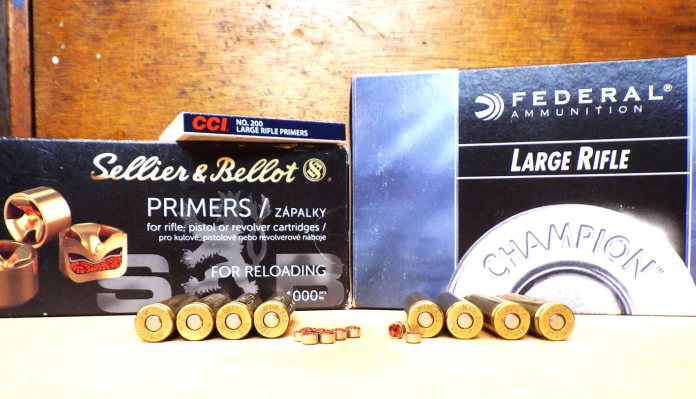Reloading Basics - The effects of switching to different primers when reloading
- Last updated: 08/05/2024

The current lack of primers in the UK is probably the most significant reloading component shortage in decades, and the prices have also gone through the roof. As a result, many reloaders are switching to different brands of primers, using whatever they can find.
The effects of changing brands and/or types of primers have been the subject of much conjecture, but the advice has always generally been along the same lines; when you change the brand of primers, but not the type, the effect can be relatively insignificant and far less noticeable than you would see if you changed the type of powder or bullet. There is rarely a detectable change in chamber pressure, and the muzzle velocity will only vary by a small degree. If you change the type of primer, like switching from standard to magnum primers, there is more risk of significantly changing the chamber pressure and this is generally considered to be bad practice.
So, is this advice correct? Well, some new test results certainly shed some light on this important subject.
The latest research
Thanks to the technical experts at Hodgdon, we now have some bang-up-to-date test data which shows the results of switching primers into a ‘standard’ load, and this is extremely useful information. Companies like Hodgdon have the equipment and facilities to fully test loads and accurately measure chamber pressures and muzzle velocities, while your average shooter can only measure the velocity to a limited degree of accuracy. Information like this is pure gold for reloaders because it helps to confirm or dispel previously held assumptions, plus helps you keep your reloading practices safe.
Standard load
Hodgdon used the .308 Win for testing, as it’s a very accurate calibre that can be loaded with a large range of widely available components. They chose Winchester brass (the same type used in their reloading data), Winchester large rifle primers, Sierra’s 168-grain MatchKing bullet, and Varget powder. The Cartridge’s Overall Length (COL) was set at 2.800” and the powder charge weight was 46.0-grains. They also ran tests using 49.0-grains of CFE223 powder, alongside the Varget, so they could also compare how single-base extruded and double-base spherical powders reacted to the different types of primers. These baseline loads were worked up to S.A.A.M.I. maximum average pressures and test fired in batches of five rounds to establish control data.
One out one in
For testing, the only change made to the standard load was to substitute different primers. Batches of five rounds were made up and test-fired with each of the primers listed in the ‘.308 Load Data’ table below. Winchester and Federal are usually two of the most readily available brands and the CCI#34 primers are popular in the states for use in .308/7.62 loads for semi-automatic applications. They are considered to have a harder cup, presumably to avoid the possibility of slam-fires in this type of rifle, but also ignite consistently.
Pressure
Pressure is the most critical safety factor with ammunition, and it is also the hardest to accurately measure, but fortunately, pressure is closely related to muzzle velocity and as one increases, so does the other. Hodgdon states that, as a general guide, a 1000 psi increase in pressure will be reflected by an increase in velocity of approximately 11 fps. It is always important to check the muzzle velocity of your loads and also watch for signs of excessive chamber pressures.
The maximum S.A.A.M.I chamber pressure for .308 Win is 62000 psi, and as the figures in the table show, changing from a standard primer to a magnum primer can easily take a safe load over that maximum pressure and risk damage to the gun and injury to the shooter. It is also worth noting that the CCI#34 primers also take the chamber pressure over the maximum safe limit, even though they are not magnum primers. This is pretty conclusive evidence that using magnum primers in place of your standard primers is not safe. With both the Varget powder and the CFE223, the switch to magnum primers, using either Federal or Winchester brands, took the pressure well over the S.A.A.M.I. maximum safe pressure.
As well as increasing the chamber pressure, the introduction of magnum primers also significantly reduces the consistency of the pressures in most cases. The Extreme Spread (ES) of the CFE223/WLR MG data is more than double that of the results with the standard WLR primer.
Other effects
As the data shows, the muzzle velocities also become far less consistent when magnum primers are introduced into the mix. If you look at the first two rows of data on the table, it shows that switching to the Winchester Magnum Primers causes both the ES and the Standard Deviation (SD) of the muzzle velocities to increase by 50%. Similar decreases in consistency occur in all of the other sets of data too, and this will show up as less consistent grouping on the target.
Conclusion
The data produced by Hodgdon clearly confirms that switching from standard to magnum primers significantly increases chamber pressure and reduces the consistency of muzzle velocities, neither of which are desirable. If you have to switch to magnum primers, because you cannot obtain standard ones, you must back off the powder charge weight to compensate for the increased chamber pressure. The recommendation here is that magnum primers should only be used when reloading data specifically calls for them.
Special thanks to Hodgdon for permitting us to use their data here.